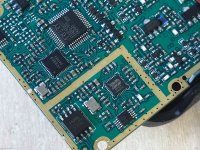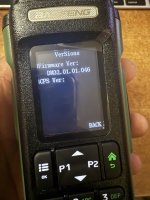This encryption is very low-end, there is no MI. In fact I've already seen this encryption, yes it uses AES128 but in the wrong way.
AES128 generates an encrypted stream in OFB mode, but the encryption is reset with each frame.
It doesn't offer any security and it can also be considered a Chinese backdoor because the security is so bad.
Claude could do the following test:
Case 1: It ranks the 5 most frequent frames of 6 bytes (we don't take care of the 7th byte) in the clear.bin file and the 5 most frequent 6-byte frames in the crypt.bin file
Case 2: It ranks the 5 most frequent 3-byte frames (starting at the beginning of the frame) in the clear.bin file and the 5 most frequent 3-byte frames in the crypt.bin file
The 5 most frequent frames will be the silence frames.
For the Case 1:
We take the most frequent frame (clear.bin) and we XOR with the most frequent frame (crypt.bin) we get 6 bytes of encrypting stream, this is the encryption key (6 bytes). we XOR the set of crypt.bin frames with this encryption key (6 bytes). We don't deal with the 7th byte.
We listen if the sound is in the clear.
if not, we take the second most frequent frame (clear.bin) and in XOR with the first most frequent frame (crypt.bin) and we do the same thing again.
if not, we take the third most frequent frame (clear.bin) and in XOR with the first most frequent frame (crypt.bin) and we do the same thing again.
if not, we take the fourth most frequent frame (clear.bin) and in XOR with the first most frequent frame (crypt.bin) and we do the same thing again.
if not, we take the fifth most frequent frame (clear.bin) and in XOR with the first most frequent frame (crypt.bin) and we do the same thing again.
And if it doesn't work, we test the 5 most frequent frames (clear.bin) with the second most frequent frames (crypt.bin)
And if it doesn't work, we test the 5 most frequent frames (clear.bin) with the third most frequent frames (crypt.bin)
And if it doesn't work, we test the 5 most frequent frames (clear.bin) with the fourth most frequent frames (crypt.bin)
And if it doesn't work, we test the 5 most frequent frames (clear.bin) with the fifth most frequent frames (crypt.bin)
It may seem confusing but Claude will understand this, it will be enough to paste here what Claude has understood from my explanation.
If this Case 1 doesn't work, we do the same thing with Case 2 where we only take care of the 3 most frequent bytes of a frame and we do the same as above.
You should know that if you decrypt only 3 bytes out of the 7, the sound will be understandable. more difficult but we will be able to recognize words.





